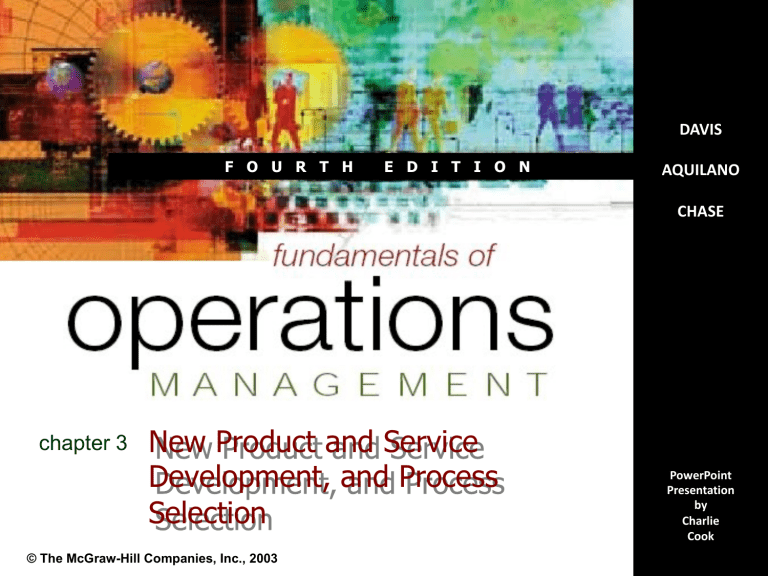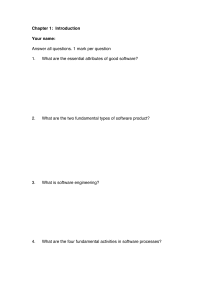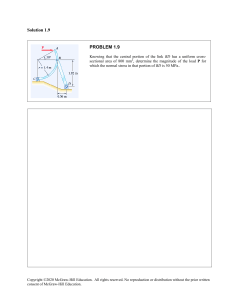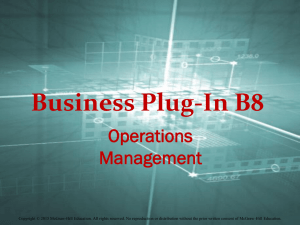
DAVIS F O U R T H E D I T I O N AQUILANO CHASE chapter 3 New Product and Service Development, and Process Selection © The McGraw-Hill Companies, Inc., 2003 PowerPoint Presentation by Charlie Cook Managerial Issues • Product life cycles becoming shorter. –The need to bring products to market more quickly and efficiently. • Conducting product development on a continuous basis. –New products may represent a majority of sales and profits. –3M an innovative company, having strength to introduce new products in the market at a faster pace with a great success record. Fundamentals of Operations Management 4e © The McGraw-Hill Companies, Inc., 2003 3–2 Why the Emphasis on New Goods and Services • Increased Competition ØAdvances in worldwide telecommunications ØLower trade barriers (import duties and tariffs) and the creation of trade organizations (NAFTA and European Union) ØFaster transportation of goods • Advances in Technology ØProducts become obsolete faster. ØCell Phone sizes & features and PC’s speed and storage are good examples. ØImproved manufacturing processes (CAD and CAM and industrial robots) Fundamentals of Operations Management 4e © The McGraw-Hill Companies, Inc., 2003 3–3 The Benefits of Introducing New Products Faster • Greater Market Share ØEarly entry captures large initial market share. ØSemi-conductor industry – first two entrants share majority of market • Price Premiums ØAbility to initially charge more for new products. ØProducts that are late to market have a –ve impact on profitability in terms of cost overruns. • Quick Reaction to Competition ØRapid response to competitor’s new products. • Set Industry Standards ØInitial product sets market/industry standards (entry barriers). Fundamentals of Operations Management 4e © The McGraw-Hill Companies, Inc., 2003 3–4 The New Product Development (NPD) Process • New Product Development Process ØThe method by which new products evolve from conceptualization through engineering to manufacturing and marketing. • Market Success Depends on NPD ØContinuously generate new product ideas. ØConvert ideas to reliable functional designs. ØEnsure that the designs are readily producible. ØSelect the processes most compatible with customer needs. Fundamentals of Operations Management 4e © The McGraw-Hill Companies, Inc., 2003 3–5 The New Product Development (NPD) Process • Concurrent Engineering ØThe simultaneous and coordinated efforts of all functional areas which accelerates the time to market for new products. Fundamentals of Operations Management 4e © The McGraw-Hill Companies, Inc., 2003 3–6 Concurrent Engineering Approach to NPD Exhibit 3.4 Fundamentals of Operations Management 4e © The McGraw-Hill Companies, Inc., 2003 3–7 The New Product Development (NPD) Process (cont’d) • Idea Generation ØMarket pull: the “voice of the customer” in providing feedback to determine product specifications. ØTechnology push: a product developed by the firm’s R&D is “pushed” into the market. Polaroid Cameras, PCs and 3M’s Post-it Notes are examples • Concept Development ØInitial product design developed and tested. ØAnalysis of the market and customer requirements. ØBusinesses today recognize the need to involve their customers in all aspects of design, production and delivery of goods and services. Fundamentals of Operations Management 4e © The McGraw-Hill Companies, Inc., 2003 3–8 The New Product Development (NPD) Process (cont’d) • Quality Function Deployment (QFD) ØThe process for translating customer requirements into a product’s design. • Voice of the Customer ØCustomer feedback is used in QFD process to determine product specifications. ØCustomer attributes: • Product needs • Product preferences ØAttributes are weighted based on their relative importance to customer. ØConsumer is asked to compare and rate the company’s products with those of its competitors. Fundamentals of Operations Management 4e © The McGraw-Hill Companies, Inc., 2003 3–9 The New Product Development (NPD) Process (cont’d) • House of Quality ØThe part of the QFD process that uses customer feedback for product design criteria. ØUse of QFD teams • Identify important customer attributes. • Design superior product. • Shorten product design time. • Facilitate inter-functional cooperation. Fundamentals of Operations Management 4e © The McGraw-Hill Companies, Inc., 2003 3–10 The New Product Development (NPD) Process (cont’d) • New Product Planning 1. Build models of new product. 2. Test new elements and components. 3. Conduct detailed investment and financial analyses of product’s anticipated life cycle. Fundamentals of Operations Management 4e © The McGraw-Hill Companies, Inc., 2003 3–11 The New Product Development (NPD) Process (cont’d) • Design for Manufacturability (DFM) ØChoosing manufacturing methods and materials. ØMinimizing the number of individual parts: • Reduces assembly time. • Increases reliability. Ø Setting product specifications. • Output from the design activity that states all criteria for building a product. Fundamentals of Operations Management 4e © The McGraw-Hill Companies, Inc., 2003 3–12 Process Selection in Manufacturing • Types of Processes –Project process • Process that focuses on making one-of-a-kind products. –Intermittent process • Process that produces products in small lot sizes (e.g., job and batch operations). –Line-flow process • Continuous process that produces high volume, highly standardized products (e.g., assembly-line and continuous operations). Fundamentals of Operations Management 4e © The McGraw-Hill Companies, Inc., 2003 3–13 Process Selection in Manufacturing • The Product-Process Matrix –High production volumes and narrow product lines make specialized equipment and standardized materials economically feasible. • Remaining in a process niche after the product cycle has advanced to its next stage dooms a firm to market failure. Fundamentals of Operations Management 4e © The McGraw-Hill Companies, Inc., 2003 3–14 New Service Development Types of Incremental and New Services Exhibit 3.10 Fundamentals of Operations Management 4e © The McGraw-Hill Companies, Inc., 2003 3–16 Categories of New Services • Incremental services – Service line extensions • New services that augment current services. – New items on restaurant menu, new airline routes. – Service improvements • New services in which features have changed relative to existing services. – E-ticketing for airlines. – Style changes • Modest forms of new services that change only the appearance of the service. • Aimed to impact the customer’s perceptions, emotions and attitudes. – Renovation of a restaurant, exterior painting of airplane with a new logo. Fundamentals of Operations Management 4e © The McGraw-Hill Companies, Inc., 2003 3–17 Categories of New Services (cont’d) • Radical – New service offerings that were not previously available or new delivery system for existing service – Major innovations • New services in markets not fully defined. Often driven by computer and information technology. – Internet banking – Start-up services • New services in established markets already served by existing services. – Development of SMART card for retail transactions, customer loyalty card by Lahore Chatkhara. – New services for current markets • Added services to current customers. – PICIC Bank’s kiosk in PC Lahore. Fundamentals of Operations Management 4e © The McGraw-Hill Companies, Inc., 2003 3–18 Categories of New Services Service Category Content Change “Window Dressing” Not significantly different from other services Delivered in similar fashion Breadth of Offering Significant design change in content of service Delivered in similar fashion Revolutionary New in both content and delivery method Channel Development Delivery of same/existing service through a different/new channel Fundamentals of Operations Management 4e © The McGraw-Hill Companies, Inc., 2003 3–19 Categories of New Services – Contd. Service Category Examples “Window Dressing” New courses at college Could be brought into market in a relatively short period of time. Breadth of Offering Marriott has variety, e.g., Fairfield Inns, Residence Inns, Marriott Courtyards and Marriott Suites. Delivered in similar fashion but content is different Revolutionary Overnight delivery service of FedEx using airplanes Channel Development ATM Machines of banks Fundamentals of Operations Management 4e © The McGraw-Hill Companies, Inc., 2003 3–20 New Service Development Process • NSD is very similar to NPD. • Designing of Product and Process is carried out simultaneously. • It is impossible to separate product from process. • The process starts with IDEA. • R & D in services occurs primarily in the operations process w.r.t. how the service is delivered. Fundamentals of Operations Management 4e © The McGraw-Hill Companies, Inc., 2003 3–21 New Service Development (NSD) Process – Contd. Stage Activity Design Formulating the objectives and strategy of the new service. Analysis Considering the financial implications of the new service. Examining supply chain issues for delivery of service. Development Testing the service design, training personnel, conducting pilot runs. Full Launch Releasing the service to the market place. Fundamentals of Operations Management 4e © The McGraw-Hill Companies, Inc., 2003 3–22 The Customer Contact Approach to Designing Service Processes • Service systems are generally classified along industry lines – Financial services, health services, transportation and etc. – Such classification does not mention much about process • Customer Contact – The presence of the customer in the system. • Extent of Contact – The percent of time the customer is involved relative to the time required to deliver the service. • Creation of the Service – The work process involved in providing the service. Fundamentals of Operations Management 4e © The McGraw-Hill Companies, Inc., 2003 3–23 The Customer Contact Approach to Designing Service Processes High Degree of Customer Contact High Low Degree of Customer Contact Percentage of customer contact (customer influence on the system) Difficulty in managing system Fundamentals of Operations Management 4e Low © The McGraw-Hill Companies, Inc., 2003 3–24 Customer Contact Approach – Contd. • Degree of customer interaction and customization, closely parallels the degree of customer contact. • The degree of labour intensity to deliver service is also important • Service Factory – Low degree of labour intensity and low degree of customer interaction and customization • Service Shop – Low degree of labour intensity but higher degree of customer interaction and customization • Mass Service – High degree of labour intensity but has a relatively low degree of customer interaction and customization • Professional Service – High degree of labour intensity as well as higher degree of customer interaction and customization Fundamentals of Operations Management 4e © The McGraw-Hill Companies, Inc., 2003 3–25 Generic Strategies for Service Organizations • Low Degree of labour intensity ØCapital intensive with high fixed costs. ØCan’t easily adjust capacity to meet changes in demand ØMust attempt to smooth out demand during peak periods by shifting it to off-peak periods • High Degree of labour intensity ØWorkforce management is paramount. ØEmphasis should be on hiring training and scheduling • Benchmarking of best-in-class companies could help Fundamentals of Operations Management 4e © The McGraw-Hill Companies, Inc., 2003 3–26 Designing a New Service Organization • “Service Vision” (Heskett) –Identification of the target market • Who is our customer? –Defining the service concept • How do we differentiate our service in the market? –Developing the service strategy • What is our service package and its operating focus? –Creating the service delivery system • What processes, staff, and facilities are needed? Fundamentals of Operations Management 4e © The McGraw-Hill Companies, Inc., 2003 3–27 Designing a New Service Organization – Contd. • The process and the product must be developed simultaneously. • Service operation itself lacks the legal protection, commonly available to goods production. • Service package constitutes the major output of development process. • Many parts of the service package often are defined by training individuals receive before they become part of organization. – Professional service organizations, e.g. law firms, hospitals require certification prior to hiring • Many service organizations can change their service offerings virtually overnight. – Barber shops, retail stores and restaurants Fundamentals of Operations Management 4e © The McGraw-Hill Companies, Inc., 2003 3–28 Service-System Design Matrix – Contd. • Buffered Core – physically separated from the customer. • Permeable System – customer can penetrate via phone or face-to-face contact • Reactive System – Penetrable and reactive to customer requirements • Greater the amount of customer contact, the greater the opportunity to generate additional sales. • Face-to-face loose specs – Fast food restaurants and Disneyland, neither customer nor server has much discretion on creating the service • Face-to-face total customization – Where the specs. to be developed through some interaction b/w customer and server, e.g., legal and medical services Fundamentals of Operations Management 4e © The McGraw-Hill Companies, Inc., 2003 3–29 Strategic Uses of the Service-System Design Matrix 1. 2. Enabling systematic integration of operations and marketing strategy. Clarifying exactly which combination of service delivery the firm is actually providing. Ø 3. Permitting comparison with other firms in the way specific services are delivered. Ø 4. This helps to pinpoint a firm’s competitive advantage. Indicating evolutionary or life cycle changes that might be in order as the firm grows. Ø 5. As the company incorporates the delivery options (listed on diagonal) it is becoming diversified in production process. The evolution of service delivery could move in either direction, unlike to that in manufacturing where from intermittent operation, movement is towards continuous operation. Providing flexibility. Ø One can go into depth, placing particular service products of a small firm or cover a large service organization at more aggregated level. Fundamentals of Operations Management 4e © The McGraw-Hill Companies, Inc., 2003 3–30 Process Selection in Services • Types of Service Organizations – Service businesses • Facilities-based services that provide assistance to customers who come to the service facility. Banks, hospitals, law firms. • Field-based services that provide on-site services to customers. Cleaning and home repair services. – Customer support services • Provide product information and services to current external customers. Product repair and maintenance services. – Internal services • Provide services for other internal organizational units. Functions such as, maintenance, accounting. Fundamentals of Operations Management 4e © The McGraw-Hill Companies, Inc., 2003 3–31 Process Selection in Services (cont’d) • The Production Line Approach ØOrientation is toward the efficient production of results— precisely controlled execution of the “central function”. ØMcDonald’s Big Mac ØBesides marketing and financial skills, the company carefully controls the execution of each outlet’s central function – the rapid delivery of a consistently uniform, high quality mix of prepared food in a clean environment, with cheerful courtesy. ØThe systematic substitution of equipment for people, combined with carefully planned use and positioning of technology enables McDonald’s to attract customers in unprecedented manner. Fundamentals of Operations Management 4e © The McGraw-Hill Companies, Inc., 2003 3–32 McDonald’s Production Line Approach ØThe McDonald’s french fryer allows cooking of the optimum number of french fries at one time. ØA wide-mouth scoop is used to pick up the precise amount of french fries for each order size. (The employee never touches the product) ØStorage space is expressly designed for a predetermined mix of pre-packaged and pre-measured products. ØCleanliness is pursued by providing ample trash cans in and outside each facility. (larger outlets have motorized sweepers for parking areas) ØHambergers are wrapped in color coded paper. ØThrough painstaking attention to total design and facilities planning, everything is built integrally into the (McDonald’s) machine itself – into the technology of system. The only choice available to the attendant is to operate it exactly as the designer intended. Fundamentals of Operations Management 4e © The McGraw-Hill Companies, Inc., 2003 3–33 Process Selection in Services – Contd. • The Customer Involvement Approach ØHaving the customer take a greater participatory role in the production of the service. • ATMs, self-service gas stations, salad bars, inroom coffee-making equipment in hotel rooms. ØThis turns customer into partial employees, who must be trained in what to do and be compensated primarily through lower prices that are charged for service. Fundamentals of Operations Management 4e © The McGraw-Hill Companies, Inc., 2003 3–34 Process Selection in Services – Contd. • The Personal Attention Approach ØThe central focus is complete customer attention and satisfaction at all times. ØIt is the concept of mass-customization, applied to services. ØEach customer is treated as an individual, with the service firm often maintaining a database of each customer’s likes and dislikes. ØThis information may be available within one particular facility or for all facilities of that organization. ØRitz-Carlton does it for all of its guests. Fundamentals of Operations Management 4e © The McGraw-Hill Companies, Inc., 2003 3–35 Common Characteristics of Well-Designed Service Systems 1. Each element of the service system is consistent with the operating focus of the firm. 2. It is user-friendly—customers can interact easily. 3. It is robust—capable of coping with variations in demand and resources availability 4. It is structured so that consistent performance by its people and systems is easily maintained. Ø Supportive technologies are truly supportive and reliable. 5. It provides effective links between the back office and the front office so that nothing falls between the cracks. Fundamentals of Operations Management 4e © The McGraw-Hill Companies, Inc., 2003 3–36 Common Characteristics of Well-Designed Service Systems (cont’d) 6. It manages the evidence of service quality in such a way that customers see the value of the service provided. Ø This is particularly true where a service improvement is made. Unless customers are made aware of improvement through explicit communication about it, the improved performance is unlikely to gain maximum impact. 7. It is cost-effective—there is a minimum waste of time and resources in delivering the service. Fundamentals of Operations Management 4e © The McGraw-Hill Companies, Inc., 2003 3–37






